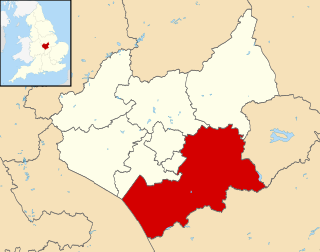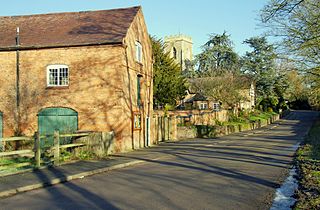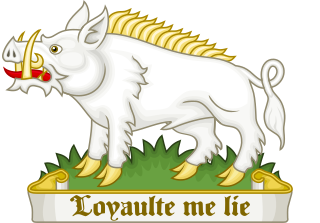Related Research Articles

The Battle of Bosworth or Bosworth Field was the last significant battle of the Wars of the Roses, the civil war between the Houses of Lancaster and York that extended across England in the latter half of the 15th century. Fought on 22 August 1485, the battle was won by an alliance of Lancastrians and disaffected Yorkists. Their leader Henry Tudor, Earl of Richmond, became the first English monarch of the Tudor dynasty by his victory and subsequent marriage to a Yorkist princess. His opponent Richard III, the last king of the House of York, was killed during the battle, the last English monarch to die in combat. Historians consider Bosworth Field to mark the end of the Plantagenet dynasty, making it one of the defining moments of English history.

The Battle of Naseby took place on 14 June 1645 during the First English Civil War, near the village of Naseby in Northamptonshire. The Parliamentarian New Model Army, commanded by Sir Thomas Fairfax and Oliver Cromwell, destroyed the main Royalist army under Charles I and Prince Rupert. Defeat ended any real hope of Royalist victory, although Charles did not finally surrender until May 1646.

Harborough is a local government district of Leicestershire, England, named after its main town, Market Harborough. Covering 230 square miles (600 km2), the district is by far the largest of the eight district authorities in Leicestershire and covers almost a quarter of the county.

Dadlington is a village administered by Hinckley and Bosworth District Council in Leicestershire, England. It is situated between Hinckley, Market Bosworth and Nuneaton.

The Battle of Edgcote took place on 24 July 1469, during the Wars of the Roses. It was fought between a Royal army, commanded by the earls of Pembroke and Devon, and a rebel force led by supporters of the Earl of Warwick.

Sutton Cheney is a village and civil parish in the borough of Hinckley and Bosworth in the county of Leicestershire, England, near the county border with Warwickshire. In addition to the village of Sutton Cheney itself, the civil parish also contains the villages of Dadlington and Shenton, a number of farms, and the location of the Battle of Bosworth. Its closest large towns are Nuneaton and Hinckley. Its closest market town is Market Bosworth.

Ambion Hill is a hill in west Leicestershire, England, south of the town of Market Bosworth and lying south of the Sutton Cheney to Shenton road and north of Dadlington and of Fenn Lanes Roman road. The Ashby Canal passes to the south of the hill.

King's Sutton is a village and civil parish in West Northamptonshire, England in the valley of the River Cherwell. The village is about 4.1 miles (6.6 km) south-east of Banbury, Oxfordshire.

Stoke Golding is a village and civil parish in the Hinckley and Bosworth district of Leicestershire, England, close to the county border with Warwickshire. According to the 2001 census, the total population was 1,721 in just over 700 houses. The population at the 2011 census was 1,684 in 723 households. The village is 16 miles (26 km) from the city of Leicester, about 3 miles (4.8 km) northwest of Hinckley and 4 miles (6.4 km) from Fenny Drayton. The village is bordered on one side by the Ashby Canal, well-used for recreational purposes, and Poland on the other.
Battlefield archaeology is a sub-discipline of archaeology which studies the material remains and topography of a battlefield to understand a conflict. Archaeological battlefields consist of skirmishes, sieges, camps, and training sites. The study of the relationships and contexts of the material by-products of war give an alternate account to the version recorded in a history book, poem, or witness account, which may be constructed though bias, or may present only a limited perspective of the events. Examination of these locations gives insight to what tactics were being used, weapon modifications, and battle formations. It is not considered distinct from Military archaeology or Recceology.

Shenton is a hamlet in west Leicestershire, lying about two miles south-west of Market Bosworth. The hamlet is included in the civil parish of Sutton Cheney and is part of Hinckley and Bosworth District. Shenton was formerly a chapelry and township of the parish of Market Bosworth. The settlement is almost entirely agricultural, containing several farms. Much of the land has been in the same family since William Wollaston purchased the manor in 1625. It is essentially a privately owned estate village and has seen comparatively little modern development. It has been designated a conservation area.
Conflict archaeology is a sub-discipline within archaeology focused on intergroup and intragroup conflict. Closely linked to battlefield archaeology and Military Sites Archaeology, conflict archaeology is developing as an umbrella sub-discipline that encompasses these others, allowing for greater epistemological elasticity than other terms. Modern conflict archaeology deals with technological, social, cultural, psychological aspects of present conflicts. Unlike battlefield archaeology, modern conflict archaeology delves deeper into the anthropological study of the conflicts rather than the physical manifestations of the battles. As stated by Nicholas Saunders in his book entitled Beyond the Dead Horizon, "These complexities are generated partly by nature of modern wars/conflicts of industrialized intensity and they incorporate political and nationalistic motivations and notions of ethnicity and identity."

The Battle of Braddock Down was a battle of the south-western campaign of the First English Civil War. It was fought on open ground in Cornwall, on 19 January 1643. An apparently easy victory for the Royalists under Sir Ralph Hopton secured Cornwall for King Charles and confirmed Hopton's reputation as a commander. Hopton also gained respect for the mercy shown to his foe, of whom 1,500 were captured during and after the battle. The precise location of the battlefield is a matter of dispute, though English Heritage believe it to be within parkland at Boconnoc.
Timothy Darvill OBE is an English archaeologist and author, best known for his publications on prehistoric Britain and his excavations in England, Wales, and the Isle of Man. He is Professor of Archaeology in the Faculty of Science and Technology Bournemouth University in England. Timothy Darvill is recognised as one of the leading authorities on Stonehenge and the British Neolithic. In April 2008 he co-directed excavations within Stonehenge, together with Professor Geoffrey Wainwright and Dr Miles Russell, to examine the early stone structures on the site. The work featured heavily in a BBC Timewatch programme which examined the theory that Stonehenge was a prehistoric centre of healing. He was appointed OBE in the 2010 Queen's Birthday Honours.

The White Boar was the personal device or badge of the English King Richard III of England, and is an early instance of the use of boars in heraldry.
Battlefields are the final resting place for thousands of unknown soldiers, both nobles and commoners, whose lives were sacrificed in the making of the history of their country. These historic assets are an intrinsic part of a nation’s identity and consciousness. They inspire strong emotions and live on in stories, poetry and music. However, the history relating to them is often hard to unravel, as there is often little to see above ground and the historical record is usually written by the victors. The UK has many historic battlefield sites, some of which have legal protection through heritage protection legislation whilst others are protected through landscape legislation. More recently, some archaeologists prefer the term "site of conflict" to "battlefield", because of the difficulty in defining the geographical extent of a site.

Richard K. Morris, OBE is an English archaeologist and historian who specializes in the study of churchyard and battlefield archaeology. Having been involved in the discipline since the early 1970s, he has worked at a number of British universities, including the University of York, the University of Leeds and the University of Huddersfield, as well as publishing a series of books on the subject of archaeology. He has also held a number of significant positions within the British archaeological community. He was director of the Council for British Archaeology from 1991-1999, and was Commissioner of English Heritage.

The remains of Richard III, the last English king killed in battle, were discovered within the site of the former Grey Friars Priory in Leicester, England, in September 2012. Following extensive anthropological and genetic testing, the remains were ultimately reinterred at Leicester Cathedral on 26 March 2015.

The Abbey of Saint Mary de Pratis, more commonly known as Leicester Abbey, was an Augustinian religious house in the city of Leicester, in the East Midlands of England. The abbey was founded in the 12th century by the Robert de Beaumont, 2nd Earl of Leicester, and grew to become the wealthiest religious establishment within Leicestershire. Through patronage and donations the abbey gained the advowsons of countless churches throughout England, and acquired a considerable amount of land, and several manorial lordships. Leicester Abbey also maintained a cell at Cockerham Priory, in Lancashire. The Abbey's prosperity was boosted through the passage of special privileges by both the English Kings and the Pope. These included an exemption from sending representatives to parliament and from paying tithe on certain land and livestock. Despite its privileges and sizeable landed estates, from the late 14th century the abbey began to suffer financially and was forced to lease out its estates. The worsening financial situation was exacerbated throughout the 15th century and early 16th century by a series of incompetent, corrupt and extravagant abbots. By 1535 the abbey's considerable income was exceeded by even more considerable debts.

All Saints' Church is an Anglican Church and the parish church of Naseby in Northamptonshire, England. It is a Grade II* listed building and stands at the southern corner of Church Street and Newlands.
References
- 1 2 Dr Glenn Foard - Profile - University of Huddersfield. Accessed 30 June 2013
- ↑ UK Battlefields Resource Centre. Accessed 30 June 2013
- ↑ Bosworth Battlefield Heritage Centre Archived 12 January 2014 at the Wayback Machine . Accessed 12 January 2014
- ↑ "Silver badge and lead shot pinpoint site of Battle of Bosworth", The Guardian, 19 February 2010. Accessed 30 June 2013